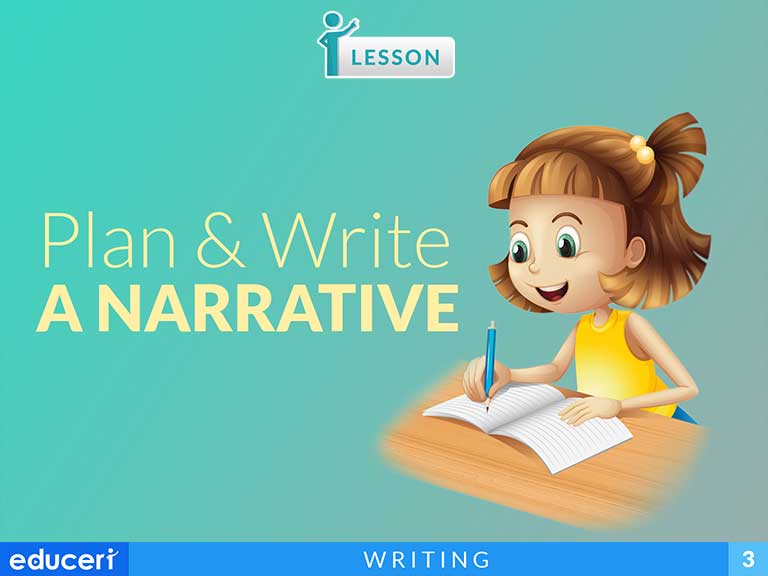All Lessons

Read and Comprehend Informational Text by Answering Questions about Topic
This reading informational text lesson focuses on reading comprehension. The lesson includes research-based strategies and strategic questions that prepare students for assessments. In this lesson, students will ask and answer questions to demonstrate understanding of a text, referring explicitly to the text as the basis for the answers. (Also aligns with 3.RI.1.)
Share This Lesson

Read and Interpret Informational Text by Answering Where, When or How Questions
This reading information text lesson focuses on reading and interpreting. In this lesson, students will answer where, when, and how questions about a text. The lesson includes research-based strategies and strategic questions that prepare students for assessments. (Also aligns with 3.RI.1.)
Share This Lesson
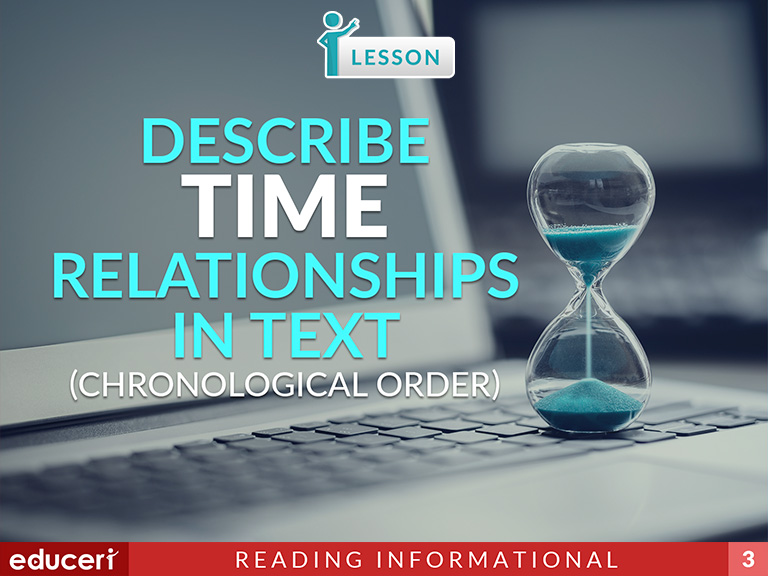
Describe Time Relationships in Text (Chronological Order)
This reading informational text lesson focuses on time relationships in text. The lesson includes research-based strategies and strategic questions that prepare students for assessments. In this lesson, students will identify time clue words (month, day, year, time, age) and then identify the time order of events in a text.
Share This Lesson

Determine Sequential Order in Text
This reading informational text lesson that describes the sequence relationships between ideas in a text. The lesson includes research-based strategies and strategic questions that prepare students for assessments. In this lesson, students will identify clue words (such as, first, last, next, etc.) and then answer questions that determine the relationship between ideas.
Share This Lesson

Follow Multiple-Step Written Instructions
This reading comprehension lesson focuses on following multiple-step written instructions. The lesson includes research-based strategies and strategic questions that prepare students for assessments. In this lesson, students use directions containing more than one step to answer questions about how to make or do something. In addition to the lesson, there are four pages of Independent Practice and review with questions modeled after current adaptive testing items.
Share This Lesson

Use Text Features to Locate Information
This reading comprehension lesson focuses on using chapter headings to locate information. The lesson includes research-based strategies and strategic questions that prepare students for assessments. In this lesson, students use chapter headings and subheadings to locate information in a table of contents or text passage. In addition to the lesson, there are five pages of Independent Practice and review with questions modeled after current adaptive testing items.
Share This Lesson

Answer Questions Referring to the Text
This Common Core reading informational text lesson focuses on reading comprehension. The lesson includes research-based strategies and strategic questions that prepare students for Common Core assessments. In this lesson, students will answer questions to demonstrate an understanding of a text, referring explicitly to the text as the basis for the answers. In addition to the lesson, there are four pages of Independent Practice and review with questions modeled after the Common Core assessment items.
Share This Lesson
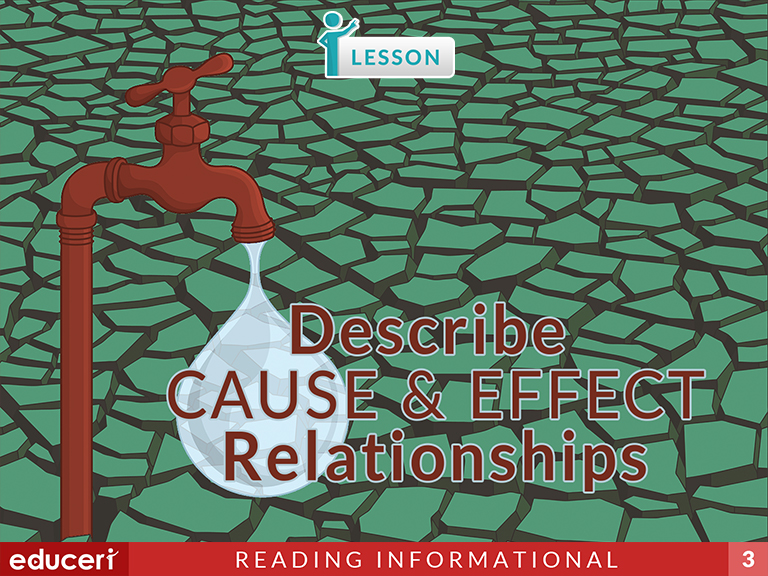
Describe Cause & Effect Relationships
This reading comprehension lesson focuses on describing the relationship between cause and effect. The lesson includes research-based strategies and strategic questions that prepare students for assessments. In this lesson, students use clues from the text they read, as well as prior knowledge to determine which event is the cause and which is the effect. In addition to the lesson, there are four pages of Independent Practice and review with questions modeled after current adaptive testing items.
Share This Lesson

Describe Text Using Information From Illustrations and Words
This reading informational text lesson explains how pictures add information to a text. In this lesson, students will describe where particular kinds of information are located within a text and its illustrations.
Share This Lesson

Compare and Contrast Two Texts on the Same Topic
This reading informational text lesson covers how to compare two texts on the same topic. The lesson includes research-based strategies and strategic questions that prepare students for assessments. In this lesson, students will learn how to compare texts by determining whether the information is in one text, the other, or both.
Share This Lesson
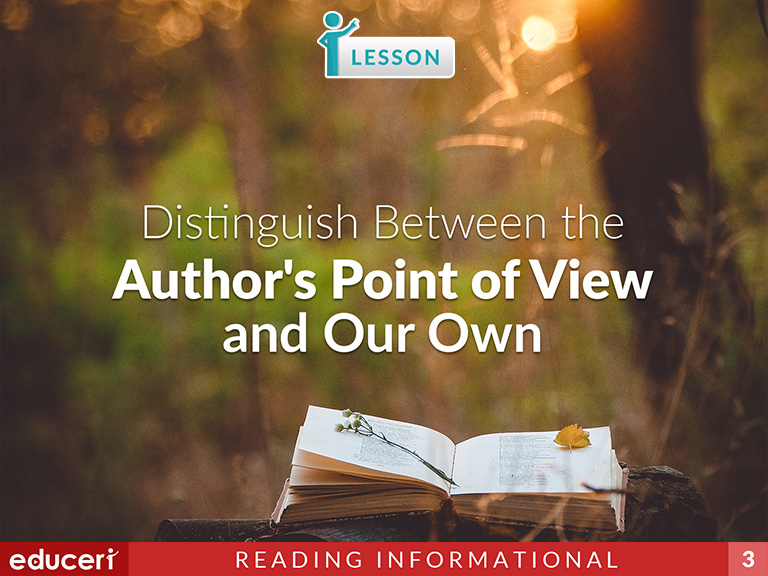
Distinguish Between the Author's Point of View and Our Own
This reading informational text lesson focuses on distinguishing between the author's point of view and our own. The lesson includes research-based strategies and strategic questions that prepare students for assessments.
Share This Lesson

Plan and Write an Opinion Piece
This writing lesson focuses on writing an opinion piece. In this lesson, students will introduce a topic or text, state their opinion, and create an organizational structure that lists appropriate reasons. (Also aligns to standard 3.W.1b.)
Share This Lesson

Plan and Write Informative Text
W.3.2 Write informative/explanatory texts to examine a topic and convey ideas and information clearly.
W.3.2.AW.3.2.A Introduce a topic and group related information together; include illustrations when useful to aiding comprehension.
W.3.2.BW.3.2.B Develop the topic with facts, definitions, and details.
W.3.2.CW.3.2.C Use linking words and phrases (e.g., also, another, and, more, but) to connect ideas within categories of information.
W.3.2.DW.3.2.D Provide a concluding statement or section.
This writing lesson helps students practice writing informative text. In this lesson, students will read given research notes on a topic, then develop a topic sentence, supporting detail sentences, and a concluding sentence using a graphic organizer. (Also aligns with standard 3.W.7.)
Share This Lesson

Write a Paragraph
This writing lesson uses teacher guidance and support to help students write a paragraph that is appropriate to the task and purpose. In this lesson, students will review a topic, write a topic sentence, add details, and a concluding idea in a graphic organizer. Then, they will write a paragraph.
Share This Lesson

Revise Writing
This writing lesson focuses on students revising written work to make it better. In this lesson, students will read a text with the main idea identified. Then, they will add or delete sentences that support or don't support the main idea.
Share This Lesson
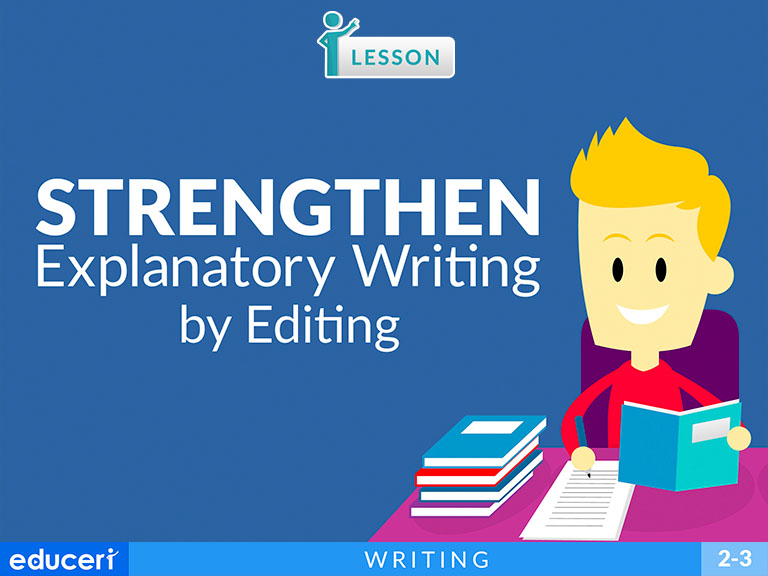
Strengthen explanatory writing by editing
W.2.5 With guidance and support from adults and peers, focus on a topic and strengthen writing as needed by revising and editing.
W.3.5W.3.5 With guidance and support from peers and adults, develop and strengthen writing as needed by planning, revising, and editing. (Editing for conventions should demonstrate command of Language standards 1-3 up to and including grade 3 here.)
2(11)(D)(ix) Edit drafts using standard English conventions, including capitalization of months, days of the week, and the salutation and conclusion of a letter.
2(11)(D)(x)2(11)(D)(x) Edit drafts using standard English conventions, including end punctuation, apostrophes in contractions, and commas with items in a series and in dates.
2(11)(D)(xi)2(11)(D)(xi) Edit drafts using standard English conventions, including correct spelling of words with grade-appropriate orthographic patterns and rules and high-frequency words.
3(11)(D)(ix)3(11)(D)(ix) Edit drafts using standard English conventions, including capitalization of official titles of people, holidays, and geographical names and places.
3(11)(D)(x)3(11)(D)(x) Edit drafts using standard English conventions, including punctuation marks, including apostrophes in contractions and possessives and commas in compound sentences and items in a series.
3(11)(D)(xi)3(11)(D)(xi) Edit drafts using standard English conventions, including correct spelling of words with grade-appropriate orthographic patterns and rules and high-frequency words.



